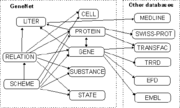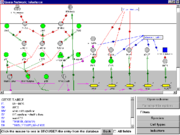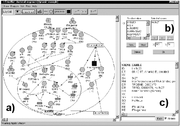Difference between revisions of "GeneNet"
Tagir Valeev (Talk | contribs) m (TRRD linked - →Formalized description) |
Tagir Valeev (Talk | contribs) m (+Category:Software) |
||
| (4 intermediate revisions by one user not shown) | |||
| Line 76: | Line 76: | ||
# references explaining the type of information described in the field; | # references explaining the type of information described in the field; | ||
# cross-references within the GeneNet database; and | # cross-references within the GeneNet database; and | ||
| − | # the references to other databases ([[EMBL]], | + | # the references to other databases ([[EMBL]], [http://www.uniprot.org/ SWISS-PROT], [[TRRD]], {{TRANSFAC}}, and {{EPD}}). |
The system enables coordinated work for several experts on shared data - at any moment only one expert can edit an entry. It also enables informing experts about any changes in their data automatically by email. | The system enables coordinated work for several experts on shared data - at any moment only one expert can edit an entry. It also enables informing experts about any changes in their data automatically by email. | ||
| Line 85: | Line 85: | ||
*[http://bioinformatics.oxfordjournals.org/content/15/7/713.full.pdf KOLPAKOV F.A.,ANANKO E.A. ''Interactive Data Input into the GeneNet Database''.Bioinformatics Oxford Journal, Volume 15, Issue 7, 1999] | *[http://bioinformatics.oxfordjournals.org/content/15/7/713.full.pdf KOLPAKOV F.A.,ANANKO E.A. ''Interactive Data Input into the GeneNet Database''.Bioinformatics Oxford Journal, Volume 15, Issue 7, 1999] | ||
* [http://www.bionet.nsc.ru/meeting/bgrs_proceedings/papers/2000/bgrs2000_1_049.pdf Ananko E.A., Kolpakov F.A., Kolchanov N.A. ''GeneNet DATABASE: A TECHNOLOGY FOR A FORMALIZED DESCRIPTION OF GENE NETWORKS.'' BGRS thesis, 2000] | * [http://www.bionet.nsc.ru/meeting/bgrs_proceedings/papers/2000/bgrs2000_1_049.pdf Ananko E.A., Kolpakov F.A., Kolchanov N.A. ''GeneNet DATABASE: A TECHNOLOGY FOR A FORMALIZED DESCRIPTION OF GENE NETWORKS.'' BGRS thesis, 2000] | ||
| + | |||
| + | [[Category:BioUML history]] | ||
| + | [[Category:Software]] | ||
Latest revision as of 16:38, 19 June 2013
The object-oriented database GeneNet was developed for accumulating information regarding regulation of gene expression, signal transduction pathways, peculiarities of gene networks organization and mechanisms of their functioning.
The GeneNet is a part of GeneExpress, an intellectual system for analysis of genomic regulatory sequences, developed at the Institute of Cytology and Genetics, Siberian Branch of the Russian Academy of Sciences.
The GeneNet system is bipartite and includes: (1) a database containing information on gene networks and (2) a Java program for automated construction of the gene network diagrams based on their formalized description in the database.
The GeneNet Java GUI (GeneNet Viewer) provides automated generation of gene network diagrams and allows for visualization and exploration of the database via the Internet. To ensure rapid data accumulation in the database, the interface was supplemented with tools for data input by independent experts having remote access to it.
As of 2000, the GeneNet database accumulated descriptions of eighteen gene networks subdivided between six sections.
The work was supported by the State Science and Technology Program "The Human Genome" of the Russian State Committee for Science and Technology, the Russian Foundation for Basic Research (grants 96-04-50006, 97-04-49740, 97-07-90309, 98-04-49479, 99-07-90203), and Integration Program of the Siberian Branch of the Russian Academy of Sciences.
[edit] Formalized description
The GeneNet original technology permitted describing any elementary structure and event occurring in pro- and eukaryotic gene networks at different hierarchical levels of organization, i.e., molecular, cellular, and referring to the whole organism levels.
Experimental data from original papers are formalized and collected in the GeneNet database. Using the object-oriented approach, the following components are distinguished in the description of the gene network:
- entities (any material objects),
- relations between the entities, and processes occurring in them (for example, viral infection, anemia, etc.).
Four classes of entities are distinguished:
- Cell (tissue, organ) entity, regarded as a definite compartment containing a certain set of entities of other classes;
- Protein;
- Gene; and
- Substance (nonprotein regulatory substance or metabolite).
Species and cell types are taken into account in the description of entities. Two classes of relations between the entities are distinguished:
- reaction, that is, the interaction between entities leading to appearance of a new entity or process, and
- regulatory event, that is, the effect of an entity on a certain reaction.
Each class of gene network components is described in its own format in a separate table. The table CELL contains the information on the cell types and lineages. Tissues and organs are also described in this table. The table GENE includes the data on the genes and their regulatory features based on the information from the TRRD. The data on proteins and protein complexes are collected in the table PROTEIN; on nonprotein regulatory substances and metabolites, in the table SUBSTANCE; on the physiological processes and the organismic state during the gene network functioning, in the table STATE. Relations between the gene network components are described in the separate table RELATION. The database is supplemented with two additional tables: SCHEME, which contains the description of the gene network graphs, and LITER with references to the original papers.
The formalized description of elementary events is based on application of several informative line codes.
ID <gene>Hs:OAS^nucleus -> <protein>Hs:OAS^cytoplasm DT 17.5.1999; Ananko E.; created. EF indirect RF Wathelet M. et al., 1986 //
It means that the protein encoded by the human oligoadenylate synthase (OAS) gene is expressed in a cytoplasm (line code ID). The relationships is indirect (line code EF), because the intermediate stages such as transcription, processing, splicing, etc. are missing.
The phosphorylation initiated by the interferon receptor II (IFNR-II) of the human protein kinase Jak1 in the cell cytoplasm is described as follows:
ID <protein>Hs:IFNR-II^cytoplasm ->> <protein>Hs:Jak1^cytoplasm -> <protein>Hs:Jak1- p^cytoplasm DT 17.5.1999; Ananko E.; created. AT switch on EF indirect RF Silvennoinen, O. et al., 1993 //
Similarly, any other elementary event may be described in the terms of GeneNet, for instance, mRNA translation, enzyme catalysis, multimerization, etc.
[edit] User interface
The GeneNet Viewer, which is a Java applet, includes means for automated generation of the gene network diagram and a system of filters as well as means for data navigation including interactive images on diagrams, on-line help, interactive cross-references within the GeneNet database and references to other databases.
All images on diagrams are interactive, i.e. if the user clicks on an image, the textual description of the corresponding entry in the GeneNet database is displayed in a special text window under the diagram. Double clicking on a gene image starts the TRRD viewer, developed using Molecular Genetics Library, and the regulatory map of the gene is visualized. The text window contains a formatted text with hypertext references of three types:
- references explaining the type of information described in the field;
- cross-references within the GeneNet database; and
- the references to other databases (EMBL, SWISS-PROT, TRRD, TRANSFAC® Professional database, and EPD).
The system enables coordinated work for several experts on shared data - at any moment only one expert can edit an entry. It also enables informing experts about any changes in their data automatically by email.
[edit] External links
- ANANKO E.A., KOLPAKOV F.A., KOLESOV G.B., KOLCHANOV N.A.GENE NETWORKS: A DATABASE AND ITS AUTOMATED VISUALIZATION THROUGH THE INTERNET IN THE GENENET COMPUTING SYSTEM.BGRS thesis, 1998
- KOLPAKOV F.A.,ANANKO E.A. Interactive Data Input into the GeneNet Database.Bioinformatics Oxford Journal, Volume 15, Issue 7, 1999
- Ananko E.A., Kolpakov F.A., Kolchanov N.A. GeneNet DATABASE: A TECHNOLOGY FOR A FORMALIZED DESCRIPTION OF GENE NETWORKS. BGRS thesis, 2000



